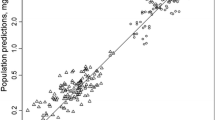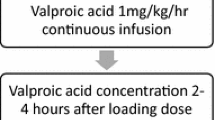Summary
A total of 20 children with various types of epilepsy were treated with valproate, 11 with monotherapy and 9 with valproate in combination with phenobarbitone, phenytoin, or carbamazepine. Valproate was given either every 8 or 12 h. At least two different dose levels were tried in each patient. The pharmacokinetics of valproate during the interval between doses was determined using a gas chromatographic technique. The clinical effect of the treatment was assessed by interviewing the parents.
The plasma concentrations showed considerable fluctuation during the intervals between doses. The mean increase from pre-administration to peak level was 82% when the dose interval was 12 h, and 62% when it was 8 h. The mean plasma half-life of valproate, using a one-compartment model, was 10.9±1.3 h (mean±SD). The plasma half-life of valproate was decreased when the drug was combined with the other anti-epileptics. The calculated area under the concentration versus time curve was linearly related to dose, both in a single patient on four dose levels and when different patients were compared. The clinical effect of valproate monotherapy was best in patients with absences, usually good in myoclonus and less favourable in other types of epilepsy. For children with absences, the optimal dose range of valproate was between 20 and 40 mg/kg/24 h. In comparison, the myoclonic types of epilepsy needed a slightly higher dose level, between 30 and 60 mg/kg/24 h. In the latter group a “therapeutic window” seems to exist, since patients below and above the suggested dose levels were not well-controlled. Therapeutic monitoring of valproate does not appear meaningful when the drug is used as monotherapy. However, in combination therapy, determination of the plasma levels of all anti-convulsants used may be helpful. The large fluctuations of valproate during a dose interval must be taken into consideration when the clinical effects are analysed.
Zusammenfassung
Zwanzig Kinder mit verschiedenen Formen einer Epilepsie wurden mit Valproinat behandelt. 11 Kinder erhielten das Medikament als Monotherapie, während bei weiteren 9 Patienten Valproinat in Kombination mit Phenobarbital, Phenytoin oder Carbamazepin verabreicht wurde. Mindestens zwei verschiedene Dosisstufen wurden bei jedem Patienten getestet. Zur Bestimmung der Valproinat-Plasmakonzentrationen und der Pharmakokinetik während eines vollständigen Dosisintervalles wurde eine gaschromatografische Methode eingesetzt. Der klinische Erfolg der Behandlung wurde durch Befragen der Eltern bestimmt.
Die Valproinat-Plasmakonzentrationen wiesen während eines Dosisintervalles erhebliche Schwankungen auf. Betrug das Dosisintervall 12 h, so lag der Unterschied zwischen der Konzentration vor Medikamentengabe und der Maximalkonzentration im Durchschnitt bei 82%; bei einem Dosisintervall von 8 h fiel dieser Wert auf 62% ab.
Bei Verwendung eines Ein-Kompartimentmodelles war die durchschnittliche Plasmahalbwertszeit 10.9±1.3 (S.D.) h. Bei Kombination mit anderen Substanzen sank dieser Wert ab.
Die Fläche unter der Konzentrations-Zeitkurve (AUC) zeigte eine lineare Korrelation zu der Dosis, sowohl bei einem einzelnen Patienten, der 4 verschiedene Dosisstufen erhalten hatte, wie auch bei einem Vergleich verschiedener Patienten. Die klinische Wirksamkeit des Valproinat war am besten bei der Behandlung von Absencen und Myoklonien, aber weniger günstig bei anderen Epilepsieformen. Bei Kindern mit Absencen erwies sich eine Valproinatdosis von 10–40 mg/kg/24 h als günstigste Dosis, während zur Therapie von Myoklonien in dieser Altersklasse etwas höhere Dosen, 30–60 mg/kg/24 h, eingesetzt werden sollten. Bei der Behandlung des letzten Krankheitsbildes scheint ein „therapeutischer Bereich“ für Valproinat zu existieren, da Patienten unterhalb und oberhalb der angegebenen Dosis sich als schlecht eingestellt erwiesen. Serumkonzentrationsbestimmungen im Sinne der Therapiekontrolle erscheinen bei Valproinat-Monotherapie nicht sinnovoll, während die Valproinatmessungen bei einer Kombinationstherapie eine gute Hilfe darstellen können.
Die starken Schwankungen der Valproinatkonzentrationen in den Dosisintervallen müssen bei der Beurteilung des klinischen Effektes in Betracht gezogen werden.
Similar content being viewed by others
References
Arnold K, Gerber N (1970) The rate of decline of diphenylhydantoin in human plasma. Clin Pharmacol Ther 11:121–134
Atkinson AJ, Shaw JM (1973) Pharmacokinetic study of a patient with diphenylhydantoin toxicity. Clin Pharmacol Ther 14:521–528
Bochner F, Hooper WD, Tyrer JH (1972) Effects of dosage increments on blood phenytoin concentrations. J Neurol Neurosurg Psychiatry 35:873–876
Boréus LO, Nergårdh A, Ehrnebo M, Theorell K (1980) A comparison between micro-crystalline and conventional phenytoin preparations: Relative bioavailability and steady-state concentrations. J Neurol 223:241–249
Bowdle TA, Levy RH, Cutler RE (1979) Effect of carbamazepine on valproic acid clearance in normal man. Clin Pharmacol Ther 25:215
Brachet-Liermain A, Demarquez JL (1977) Pharmacokinetics of dipropyl acetate in infants and young children. Pharm Weekbl 112:293–297
Browne TR (1980) Valproic acid. N Engl J Med 302:661–666
Gram L, Flachs H, Würtz-Jørgensen A, Parnas J, Andersen B (1979) Sodium valproate, serum level and clinical effect in epilepsy: A controlled study. Epilepsia 20:303–312
Johannessen SI, Hendriksen O (1977) Serum levels of di-n-propyl acetate in epileptic patients. Pharm Weekbl 112:287–289
Klotz U, Schweizer C (1980) Valproic acid in childhood epilepsy: anticonvulsive efficacy in relation to its plasma levels. Int J Clin Pharmacol Ther Toxicol 18 [10]:461–465
Mihaly GW, Vajda FJ, Miles JL, Louis WJ (1979) Single and chronic dose pharmacokinetic studies of sodium valproate in epileptic patients. Eur J Clin Pharmacol 16:23–29
Nutt JG, Kupferberg HJ (1979) Linear relationship between plasma concentration and dosage of sodium valproate. Epilepsia 20:589–592
Schobben F, van der Kleijn E, Gabreeks FJM (1975) Pharmacokinetics of di-n-propylacetate in epileptic patients. Eur J Clin Pharmacol 8:97–105
Author information
Authors and Affiliations
Additional information
Supported by the Swedish Medical Research Council (Project No. 522), Stiftelsen Margarethahemmet, and Sällskapet Barnavård
Rights and permissions
About this article
Cite this article
Lundberg, B., Nergårdh, A. & Boréus, L.O. Plasma concentrations of valproate during maintenance therapy in epileptic children. J Neurol 228, 133–141 (1982). https://doi.org/10.1007/BF00313758
Received:
Issue Date:
DOI: https://doi.org/10.1007/BF00313758




